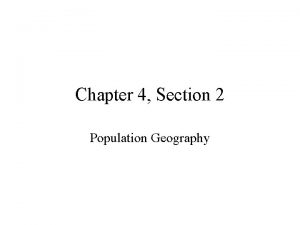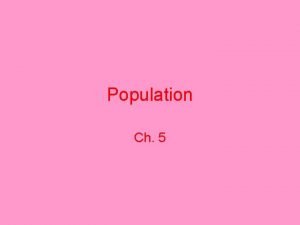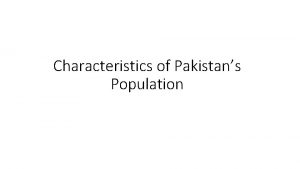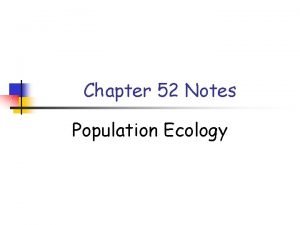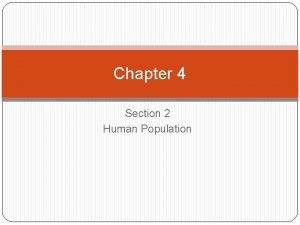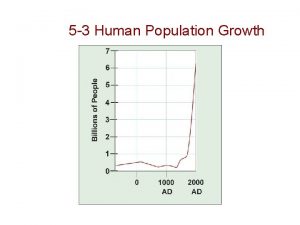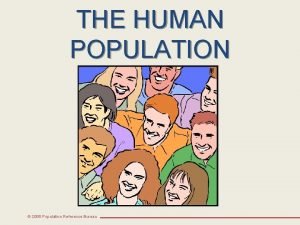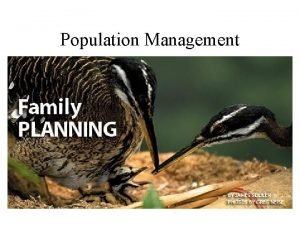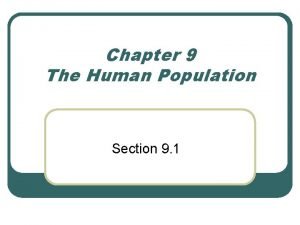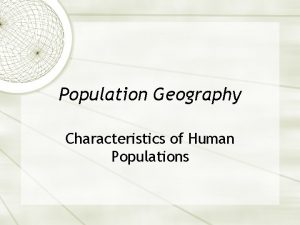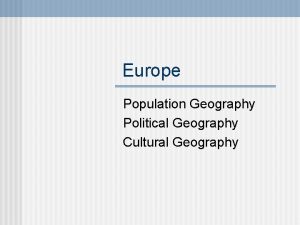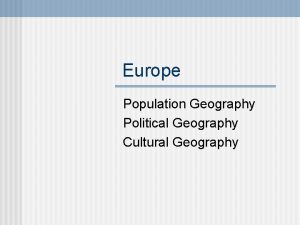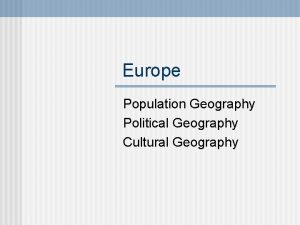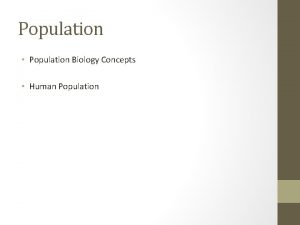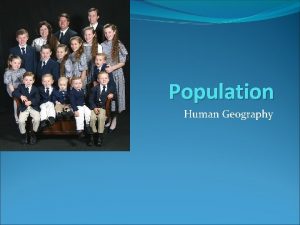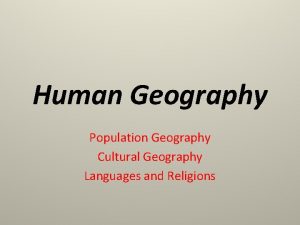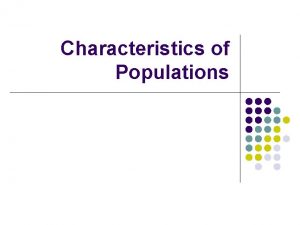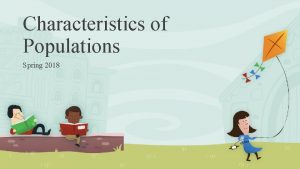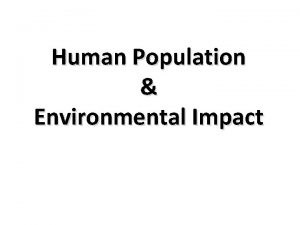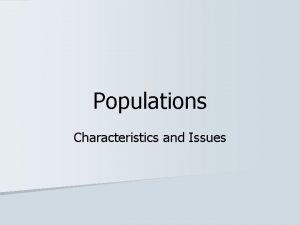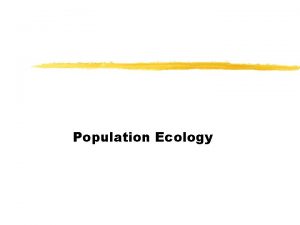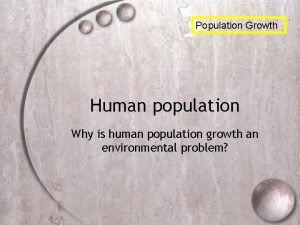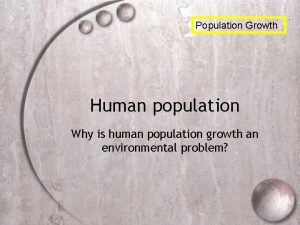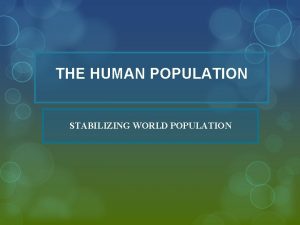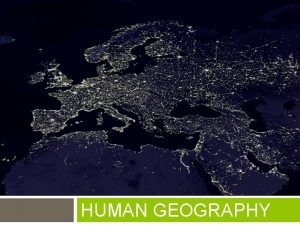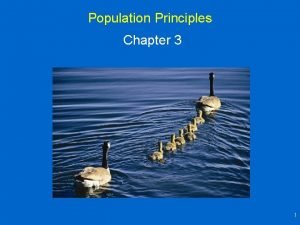Population Geography Characteristics of Human Populations Human populations





























- Slides: 29

Population Geography Characteristics of Human Populations

Human populations around the world differ by densities, distributions, ethnicities, languages, religions, and other factors. Imagine traveling to China and then to Northern Canada. How might the populations vary in these areas?

How do Geographers Compare Populations? Birth and Death Rates Age Distribution Male/Female Distribution Life Expectancy Infant Mortality Urban/Rural

Gross Domestic Product Ethnicity Language Religion Level of Education

Birth and Death Rates Birth and death rates refer to how many people are born and how many people die. Developing countries have high death rates and birth rates.

Birth and Death Rates Birth rates are higher in developing countries for the following reasons: 1. No birth control 2. Religious restrictions 3. Economic factors 4. The role of women in society

Birth and Death Rates Death rates are higher in developing countries for the following reasons: 1. No access to medical care 2. Poor nutrition


Age Distribution Age distribution refers to the number of young people compared to older people in a given population.

Age Distribution Developed countries, such as the United States, Canada, and most of Europe have an aging population. This happens when people are having fewer children and living longer. This translates to a shortage of laborers.



Male/Female Distribution This is self explanatory. Some areas have an imbalanced male/female distribution. A good example is when settlers first came to Jamestown. For many years the colony had more males than females.

Male/Female Distribution China has a one child policy. Families are restricted to having one child or they face penalties imposed by the government. This led to female infanticide or the killing of girl infants.

Life Expectancy Life expectancy is how long a person will live. Life expectancy is longer in developed countries, mainly due to better medical care. Statistically, women live longer than men.


Infant Mortality Infant mortality is the number of babies that die at birth. This number is usually per every 1, 000 people in a population.

Infant Mortality Infant mortality is very high in developing countries. For instance, some African countries have an infant mortality rate that is over 10%.


Urban/Rural Ratio The urban/rural ratio is the number of people who live in the countryside versus the city. Countries like Japan, Singapore, and Korea have many more people who live in large cities than the countryside.

Urban/Rural Ratio Over the last 100 years people have been migrating to large cities in the United States. Our population is becoming more urban.

Gross Domestic Product GDP is the total of all goods and services produced in a country in one year. Developing countries and poor populations have a low GDP.


Ethnicity was defined during the unit on culture. Obviously, different populations around the world have different ethnic compositions.

Ethnicity The ethnicity of the United States is relatively diverse because the United States is composed of immigrants while Japan has a homogeneous population.

Language Different populations speak different languages. English and Spanish are the two most spoken languages in the United States, but countries like Nigeria have over 200 spoken languages.

Religion Two different populations may follow different religions. Protestant Christianity is the largest religion in the United States while Hinduism is the main religion in India.

Education The level of education differs between populations. Developing countries normally have poor education systems or children do not have the opportunity to go to school.

 Eugenic population policies ap human geography
Eugenic population policies ap human geography Ap human geography frqs
Ap human geography frqs 5 themes of geography ap human geography
5 themes of geography ap human geography Stateless nation
Stateless nation Chapter 4 section 1 population dynamics
Chapter 4 section 1 population dynamics Section 1 population dynamics
Section 1 population dynamics Population ecology section 1 population dynamics
Population ecology section 1 population dynamics Population ecology chapter 4 answers
Population ecology chapter 4 answers Human development index definition ap human geography
Human development index definition ap human geography Chapter 4 section 2 population geography
Chapter 4 section 2 population geography Characteristics of population
Characteristics of population Characteristics of pakistan
Characteristics of pakistan Population characteristics
Population characteristics Population characteristics
Population characteristics Characteristic of population
Characteristic of population Characteristics of optimum population
Characteristics of optimum population Chapter 4 section 2 human population answer key
Chapter 4 section 2 human population answer key Section 1 population dynamics answer key
Section 1 population dynamics answer key Population growth concept map answers
Population growth concept map answers Global population age distribution
Global population age distribution Human population
Human population Famous manifestors human design
Famous manifestors human design Av
Av Chapter 9 the human population section 1
Chapter 9 the human population section 1 Brownfields ap human geography
Brownfields ap human geography Ap human geography chapter 11 vocab
Ap human geography chapter 11 vocab Topographic map definition ap human geography
Topographic map definition ap human geography Alpha beta gamma cities ap human geography
Alpha beta gamma cities ap human geography Sustainable development goals ap human geography
Sustainable development goals ap human geography Weber's least cost theory ap human geography
Weber's least cost theory ap human geography









